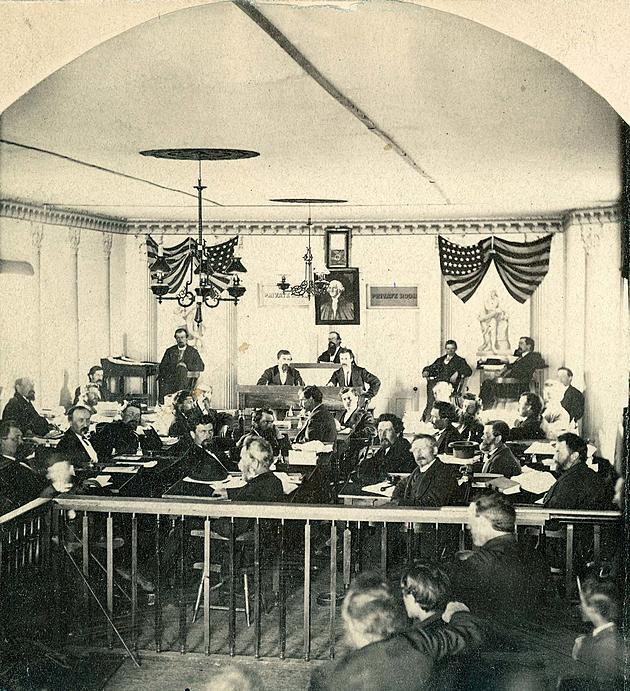HELENA — Montana has a couple of tricky spellings. For example, Chouteau County is spelled differently than how the town of Choteau is spelled, and asking someone to pronounce “Meagher” is an easy way to figure out if they grew up in the state.
You might think Lewis and Clark County is a bit easier, but if you go down the county courthouse you’ll see inscribed in stone Lewis and “Clarke” County.
“That is not a misspelling,” explained City and County Heritage Preservation Officer Pam Attardo. "At the time that the courthouse was built, it was in fact Lewis and ‘Clarke’ county with an ‘e’ at the end.”
To better understand the reason for the “Clarke” spelling we need to go back to before there was a Montana and all this land was Idaho, the Idaho territory that is.

In 1863, Sidney Edgerton, an abolitionist and congressman from Ohio, was appointed by President Lincoln to be chief justice of the Idaho Territory. At the time, the United States was in the middle of the Civil War.
Edgerton was to report to Lewiston, Idaho’s territorial capital, but due to upcoming winter weather, he and his family decided to go to Bannack instead.
After arriving in Bannack, he saw firsthand the state of the law in the area. His nephew Wilbur Fisk Sanders became involved in the Alder Gulch Vigilantes, the same group responsible for the hanging of Sheriff Henry Plumber and other vigilante justice in the area.
Residents of Bannack felt ignored by Lewiston and selected Edgerton to make a case to Washington to make Montana its own territory, a role he was uniquely qualified for. Edgerton saw the value of the growing gold fields to the Union and was a friend of Congressman James Ashley who chaired the House Committee on Territories.

Through his lobbying to Congress and President Lincoln, Montana was made its own territory in May of 1864. Bannack was named the capital and Edgerton its Governor.
Edgerton also got a county named for him in the new territory, the same county where a little gold mining town of Helena would pop up.

The first territorial governor’s leadership of Montana would be short-lived. By May 1865, the Civil War was over. There was already a sizable population of Confederate sympathizers in Montana, and the number only grew as people from the South sought out new homes in the new territory.
Helena resident Cornelius Hedges, a practicing lawyer and member of the Yellowstone expedition, recounted the tensions between Union loyalists and Confederate sympathizers in his papers.
“I looked at some of his journals on another issue, and he mentioned in there that at the time that Lee surrendered, there were more Confederates in Helena than there were Union folks,” noted Attardo. “And they were afraid. The Union folks want to put up a flag, but they're afraid that the Confederate person may remove it.”

Afraid enough that Hedges sat, riffle in hand, all night by the window of his law office watching to see if anyone tried to take down the Union flag.
In a letter from A.J. Smith to John Potter, 26 March 1864, Smith stated a Confederate sympathizer “flourishing a revolver, swearing that he would shoot [anyone] that would say that he was a Lincoln man or an abolitionist.”
Edgerton would leave Montana in September 1865 in an effort to secure additional funding for the territory, which is when Thomas Meagher took over as acting governor. Communication to Washington was difficult and the telegraph line had not been built to Montana yet.
He did not get his funding and despite remaining governor until 1866, Edgerton didn’t return to Montana for 25 years.
In 1868, the Democrat-controlled legislature, who despised the Republican territorial governor, renamed Edgerton County to Lewis and Clarke County. Which is not how Captain Clark spelled his name. Taking a trip to Pompeys Pillar northeast of Billings, people can see exactly how Clark carved his name into the stone.

So why the “e”? Well honestly, it was probably just a simple spelling error. After all, they didn’t have spell check in the 1860s.
“I’m sure there were people who at the time it was written and renamed realized it was not correct but that was the legislative record so you had to go with what was of record,” said Attardo.
For more than three decades the extra e remained, maybe one last remnant of Edgerton, until it was corrected to Clark’s proper spelling in 1905. The change coincided with the centennial celebration of the Lewis and Clark Expedition.

Although politicians in the 1800s tried to erase Edgerton’s legacy, his influence endured. Remember his nephew Wilbur Fisk Sanders? Well, Sanders became the first senator for the State of Montana and for 30 years was the president of the Montana Historical Society.
Sanders also got a county named after him.





